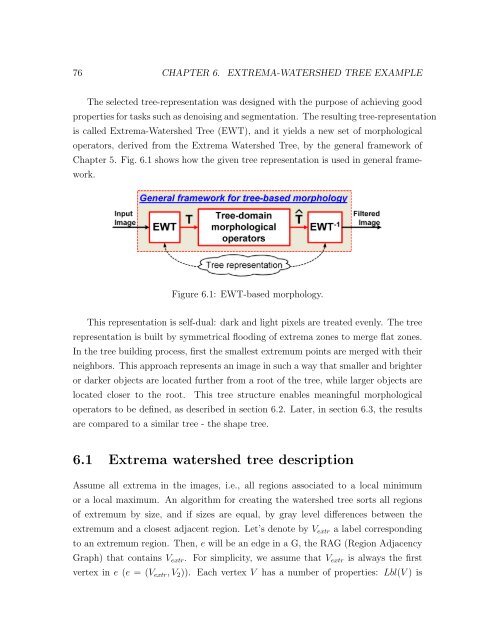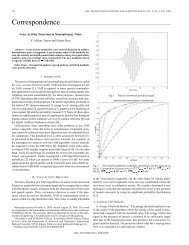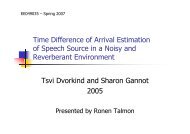Thesis (PDF) - Signal & Image Processing Lab
Thesis (PDF) - Signal & Image Processing Lab
Thesis (PDF) - Signal & Image Processing Lab
Create successful ePaper yourself
Turn your PDF publications into a flip-book with our unique Google optimized e-Paper software.
76 CHAPTER 6. EXTREMA-WATERSHED TREE EXAMPLE<br />
The selected tree-representation was designed with the purpose of achieving good<br />
properties for tasks such as denoising and segmentation. The resulting tree-representation<br />
is called Extrema-Watershed Tree (EWT), and it yields a new set of morphological<br />
operators, derived from the Extrema Watershed Tree, by the general framework of<br />
Chapter 5. Fig. 6.1 shows how the given tree representation is used in general frame-<br />
work.<br />
Figure 6.1: EWT-based morphology.<br />
This representation is self-dual: dark and light pixels are treated evenly. The tree<br />
representation is built by symmetrical flooding of extrema zones to merge flat zones.<br />
In the tree building process, first the smallest extremum points are merged with their<br />
neighbors. This approach represents an image in such a way that smaller and brighter<br />
or darker objects are located further from a root of the tree, while larger objects are<br />
located closer to the root. This tree structure enables meaningful morphological<br />
operators to be defined, as described in section 6.2. Later, in section 6.3, the results<br />
are compared to a similar tree - the shape tree.<br />
6.1 Extrema watershed tree description<br />
Assume all extrema in the images, i.e., all regions associated to a local minimum<br />
or a local maximum. An algorithm for creating the watershed tree sorts all regions<br />
of extremum by size, and if sizes are equal, by gray level differences between the<br />
extremum and a closest adjacent region. Let’s denote by Vextr a label corresponding<br />
to an extremum region. Then, e will be an edge in a G, the RAG (Region Adjacency<br />
Graph) that contains Vextr. For simplicity, we assume that Vextr is always the first<br />
vertex in e (e = (Vextr, V2)). Each vertex V has a number of properties: Lbl(V ) is
















